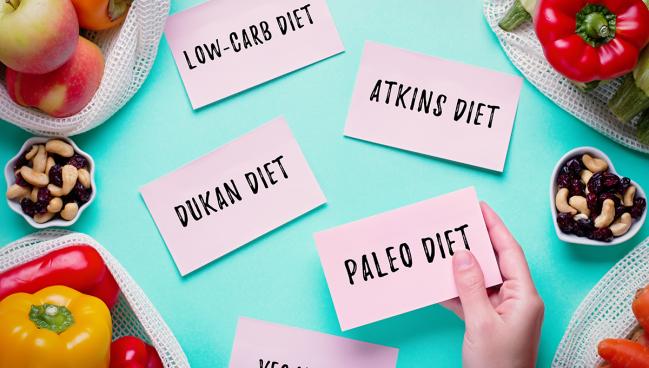Not All Diets Measure Up for Protecting the Heart: AHA
A new scientific statement ranks 10 different eating styles—the DASH diet got a perfect score, but Paleo and keto fell far short.

Some popular diets are better than others at promoting cardiovascular health, as a new scientific statement from the American Heart Association (AHA) makes clear. The report looked at how well 10 different eating styles—ranging from old standbys like the DASH (Dietary Approaches to Stop Hypertension) and Mediterranean diets to the currently trendy Paleo and ketogenic diets—line up with the AHA’s own advice.
Paleolithic and keto diets fell notably short in the ranking thanks to their emphasis on animal-sourced foods and restrictions against whole fruit, legumes, and whole grains. The DASH diet, with its flexibility to choose among many healthful options, and by virtue of being rich in vegetables, fruits, whole grains, and plant-based proteins, came out ahead.
Maya K. Vadiveloo, PhD, RD (University of Rhode Island, Kingston), vice chair for the document, said it arrives in the context of the AHA’s most-recent dietary guidance. With the new statement, they sought to spark discussions, not only “because diet is regularly in the news and there are a lot of emerging patterns that people are curious about, but also to figure out how to operationalize some of the guidance, so that clinicians and the average, everyday consumer can implement these goals more easily,” she said. “It’s trying to make it more clear-cut and interpretable.”
In the paper, published online in Circulation, the authors explore the many structural barriers that can make it hard for individuals to consume a heart-healthy diet and suggest policies and other ways to overcome them at a societal level. “Given that diet is the leading risk factor for seven of the 10 leading causes in death in the United States, [we wanted to] emphasize how it can be achieved in a lot of different ways,” added Vadiveloo. “Now is the time to be marshalling resources to improve diet quality in the population.”
DASH Diet Came in First
The writing group, chaired by Christopher D. Gardner, PhD (Stanford University Medicine/Stanford Prevention Research Center, CA), ranks the diets on a scale of 1 to 100 based on their concordance with the 2021 dietary guidance, which, in a departure from its predecessors, took a big-picture approach by focusing on dietary patterns, rather than on individual foods or nutrients.
The AHA’s dietary guidance involves 10 components: a variety of fruits and vegetables, whole grain foods, healthy proteins (mostly plants), liquid plant oils, minimally processed foods, few foods/beverages with added sugars, little or no salt, limited or no alcohol, consistency no matter where food is prepared or consumed, and attaining an energy balance to maintain a healthy weight.
For this paper, the latter category was excluded, “mostly because none of the patterns were specifically developed for weight loss,” said Vadiveloo. Also, “from a cardiovascular perspective, diet quality is an independent risk factor from body weight. . . . And even if your weight doesn’t change, improving your [diet] is going to yield cardiovascular benefits.”
The writing group considered 10 dietary patterns: DASH, Mediterranean, pescatarian, ovo/lacto-vegetarian, vegan, low fat, very low fat, low carbohydrate, Paleolithic, and very low carbohydrate/ketogenic (eg, Atkins).
Only the DASH diet got a perfect score, though the Mediterranean, pescatarian, and ovo/lacto-vegetarian diets also made it into tier 1. Tier 2, meanwhile, contained the vegan and low-fat diets. In tier 3 were the very-low-fat and low-carb diets, with Paleo and very-low-carbohydrate/ketogenic diets falling into tier 4.
The tier-4 diets “align poorly” with the AHA dietary guidance, the authors stress. Their restrictive qualities “may lead to nutritional deficiencies and loss of beneficial phytochemicals found in plant-based foods consistently associated with reduced morbidity and mortality,” they note. “Although a balanced very-low-carb diet/ketogenic or Paleo diet can have healthy attributes, patients should be counseled that overconsuming fatty meats and sodium may be detrimental to health. In addition, [these] diets are high in fat without limiting saturated fat, leading to increases in low-density lipoprotein cholesterol.”
Plus, said Vadiveloo, for her as a registered dietician, these highly-restrictive diets stand out as being hard to follow over the long term, which could lead to more weight cycling.
There are a lot of ways for making the food space inviting for all ages, races/ethnicities, cultures, dietary preferences. Maya K. Vadiveloo
Clinicians, when counseling patients, should first ask them what their goals are and what they’re currently doing, she advised. Even for someone attempting to follow the Mediterranean diet, their emphasis could be too strongly on olive oil, for example, rather than the other components.
Changes don’t have to be big in order to matter, advised Vadiveloo. For “a person who’s not eating any vegetables, adding a serving of vegetables at lunch or dinner is a great step in that direction. These are things they can work toward and develop” with their lifestyle, budget, and other individual situations in mind, she added.
As for what should come next, “the optimist in me always hopes that there are policy implications from this [work],” said Vadiveloo. Subsidies for fruits and vegetables would be a start, she suggested. It’s clear that “just labeling things isn’t adequate for changing dietary behavior, so doing things that increase the availability and affordability of healthy foods as a default in environments [where] we eat I think would be a wonderful step in this country.”
As the paper notes, the options are many, from educating individuals to fostering networks of social support, addressing structural racism through more-inclusive research, and more.
“There are a lot of ways for making the food space inviting for all ages, races/ethnicities, cultures, dietary preferences. I just hope that we can start to make it easier for people to do this,” Vadiveloo said. “It is challenging to adhere to these dietary patterns, so anything we can do to make it easier we should be doing.”
Caitlin E. Cox is News Editor of TCTMD and Associate Director, Editorial Content at the Cardiovascular Research Foundation. She produces the…
Read Full BioSources
Gardner GD, Vadiveloo MK, Petersen KS, et al. Popular dietary patterns: alignment with American Heart Association 2021 dietary guidance: a scientific statement from the American Heart Association. Circulation. 2023;Epub ahead of print.
Disclosures
- Gardner and Vadiveloo report no relevant conflicts of interest.





Comments